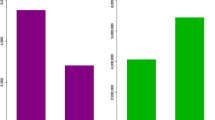Abstract
Because legislation affects so many aspects of the labor market, unions have long considered the political arena to be a major battleground. This paper investigates fund raising, a primary ingredient of this political activity. Specifically, the pattern of campaign contributions from labor PACs (and corporate PACs) is explained as an interaction of supply and demand. The results suggest that the demand for funds depends on the tightness of the race, the tenure of the incumbent, and ideology. Contributors are more willing to support ideological allies, expected winners, and powerful candidates.
Similar content being viewed by others
References
Adamany, David and George E. Agree.Political Money: A Strategy for Campaign Financing in America. Baltimore, MD.: Johns Hopkins University Press, 1975.
Bennett, James T. “Symposium on Unions and Politics: Introductory Remarks.”Journal of Labor Research 5 (Summer 1984): 263.
Chappell, Henry W. “Campaign Contributions and Congressional Voting: A Simultaneous Probit-Tobit Model.”Review of Economics and Statistics 64 (February 1982): 77–83.
Cooper, Joseph and William West. “The Congressional Career in the 1970’s.” InCongress Revisited, ed. Lawrence Dodd and Bruce Oppenheimer, 2nd ed. Washington D.C.: Congressional Quarterly Press, 1981, 83–106.
Ehrenhalt, Alan.Politics in America: Members of Congress in Washington and at Home. Washington, D.C.: Congressional Quarterly Press, 1983.
Feldstein, Paul J. and Glenn A. Melnick. “Political Contributions by Health PACs to the 96th Congress.”Inquiry (Winter 1982): 283–294.
Fenno, Richard E., Jr.Home Style: House Members in Their Districts. Boston: Little Brown and Co., 1978.
Fiorina, Morris P.Congress: Keystone of the Washington Establishment. New Haven, Conn.: Yale University Press, 1977.
Friedman, Milton. “Some Comments on the Significance of Labor Unions for Economic Policy.” InThe Impact of the Union, ed. D. M. Wright. New York: Harcourt Brace, 1951.
Fowler, Linda L. “How Interest Groups Select Issues for Rating Voting Records of Members of the U.S. Congress.”Legislative Studies Quarterly 7 (1982): 401–413.
Gopoian, J. David. “What Makes PACs Tick? An Analysis of the Allocative Patterns of Economic Interest Groups.”American Journal of Political Science (1984): 259–281.
Halvorsen, R. and R. Palmquist. “The Interpretation of Dummy Variables in Semilogarithmic Equations.”The American Economic Review (June 1980): 474–475.
Herndon, James F. “Access, Record, and Competition as Influences on Interest Group Contributions to Congressional Campaigns.”Journal of Politics 44 (1982): 996–1019.
Jacobson, Gary C.Money in Congressional Elections. New Haven, Conn.: Yale University Press, 1980.
_____ “Incumbents’ Advantages in the 1978 U.S. Congressional Elections.”Legislative Studies Quarterly 6 (May 1981): 183–200.
_____The Politics of Congressional Elections. Boston: Little, Brown, and Co., 1983.
Kau, James B. and Paul H. Rubin.Congressmen, Constituents, and Contributors. Boston: Martinus Nijhof for Public Choice Society, 1982.
_____, Donald Keenan, and Paul H. Rubin. “A General Equilibrium Model of Congressional Voting.”Quarterly Journal of Economics (May 1982): 271–93.
Kmenta, Jan.Elements of Econometrics. New York: Macmillan Publishing Company, Inc. 1971.
Krehbiel, Keith and John R. Wright. “The Incumbency Effect in Congressional Elections: A Test of Two Explanations.”American Journal of Political Science 27 (1983): 140–157.
Malbin, Michael J. “Campaign Financing and the Special Interests.”The Public Interest 56 (1979): 21–42.
Peltzman, Sam. “Constituent Interest and Congressional Voting.”Journal of Law and Economics 27 (1984): 181–210.
Sabato, Larry J.PAC Power: Inside the World of Political Action Committees. New York: W. W. Norton and Co., 1984.
Sorauf, Frank J. “Political Action Committees in American Politics: An Overview.” InWhat Price PACs? New York: Twentieth Century Fund, 1984.
Theil, Henri.Principles of Econometrics. New York: John Wiley and Sons, Inc., 1971.
Welch, W. P. “The Allocation of Political Monies: Economic Interest Groups.”Public Choice 35 (1980): 97–120.
_____. “Campaign Contributions and Legislative Voting: Milk Money and Dairy Price Supports.”Western Political Quarterly 35 (December 1982): 478–95.
Author information
Authors and Affiliations
Rights and permissions
About this article
Cite this article
Wilhite, A., Theilmann, J. Unions, corporations, and political campaign contributions: The 1982 house elections. Journal of Labor Research 7, 175–185 (1986). https://doi.org/10.1007/BF02685309
Issue Date:
DOI: https://doi.org/10.1007/BF02685309




